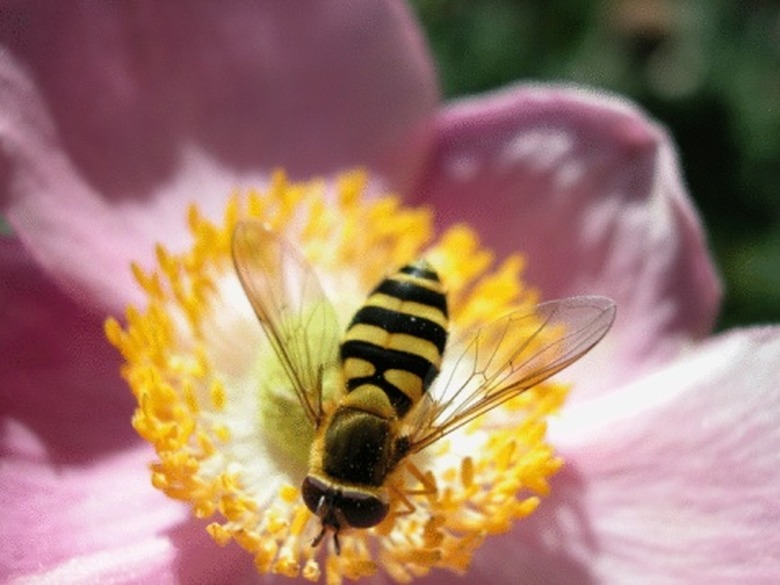Advantages & Disadvantages Of Pollination
Pollination is when pollen is transferred from the male stamen to a flower's pistil for fertilization. Cross-pollination is when genes are transferred from one plant to another during fertilization. Self-pollination is when an individual plant can pollinate itself and make new individuals. There are many advantages and disadvantages of cross-pollination and self-pollination.
Advantages of Self-Pollination
Advantages of Self-Pollination
Some plants can self-pollinate, though many, like avocados (Persea americana), take measures to avoid it such as having separate male and female flowers opening at different times of the day. The reason plants self-pollinate is to create new offspring when pollen from other plants is hard to find. Self-pollination is especially useful in plants found in geographically isolated areas, like islands.
Disadvantages of Self-Pollination
Disadvantages of Self-Pollination
The disadvantage of self-pollination is that all the offspring are genetically identical. When the environment is stable, this may not be a problem; however, when the environment changes or a new disease spreads, this can be disastrous due to a lack of genetic diversity. Low genetic diversity means that a population has a limited level of natural resistance to change.
Low Genetic Diversity Impacts
Low Genetic Diversity Impacts
Take kiwifruit (Actinidia deliciosa) in New Zealand to illustrate the potentially negative impacts of low genetic diversity. Kiwifruit has been bred for over 100 years to produce consistent and reliable fruit yields, texture and flavors. In 2010, PSA bacteria (Pseudomonas syringae pv. Actinidiae) spread throughout the country, infecting and killing kiwifruit crops and costing the industry more than NZ$400 million. The reason that kiwifruit was affected so badly and quickly across the country was due to a low genetic diversity of the monoculture cultivars. To combat the devastating spread of PSA, scientists worked hard to find kiwifruit cultivars with a natural PSA resistance.
Advantages of Cross-Pollination
Advantages of Cross-Pollination
When the pollen of viable mates is abundant and easily available, cross-pollination is plants' preferred route to reproduction. Cross-pollination results in a higher genetic diversity of offspring, and therefore, a higher survival rate when faced with a variety of situations. As the Red Queen Hypothesis explains, a species must evolve and constantly adapt to keep up with competing organisms.
Disadvantages of Cross-Pollination
Disadvantages of Cross-Pollination
Plants focused on cross-pollination typically need to produce more pollen as one of the disadvantages of cross-pollination is a risk that pollination will fail due to distance and pollen wastage. This is evident in spring when pollen from wind-pollinated conifer trees of the Pinophyta order leave a yellow coating everywhere.
Another disadvantage is that plants rely on external vectors such as animals, wind or water to transfer their pollen to the right plant. Finally, while cross-pollination increases beneficial genetic diversity, this process also increases the chance of deleterious genetic mutations and harmful gene combinations arising.
Artificial Pollination Advantages
Artificial Pollination Advantages
Artificial pollination is a method used by horticulturists to manually transfer pollen from one plant to another, triggering fertilization. Pollinating plants manually is useful when growers want to use a particular plant's genetics and cross it with another to reproduce more specific adaptations.
Another situation in which artificial pollination is useful is when natural pollination processes are slow or non-existent. For example, vanilla (Vanilla planifolia) is grown throughout the Pacific Islands and in greenhouses across the world for its pods; however, vanilla flowers are only fertilized naturally by the now rare Melipona bee (Melipona beecheii), endemic to Mexico. Therefore, if growers want the valuable pods, they must artificially pollinate vanilla flowers.
Artificial Pollination Disadvantages
Artificial Pollination Disadvantages
The primary artificial pollination disadvantages are that it is time consuming, and fertilization is not guaranteed. Artificial pollination can also take careful training of staff. For example, vanilla growers have an eight- to 12-hour window after blossoming to pollinate flowers. After this period, or if the worker doesn't deliver the pollen package effectively, the flower will wilt and die without producing a pod.
References
- Science Learning Hub: Kiwifruit – Learning to Live With PSA
- Science Learning Hub: Plant Pollination
- Ecological Processes: Pollinator-Mediated Self-Pollination and Reproductive Assurance in an Isolated Tree of Magnolia Grandiflora L.
- Biology Letters: Getting Somewhere With the Red Queen: Chasing a Biologically Modern Definition of the Hypothesis
- Vanilla Pura: Vanilla Bee Extinction
- The Oklahoman: Hand-Pollination Used to Produce Vanilla
- Science Learning Hub: Artificial Pollination
- U.S. Forest Service: What Is Pollination?
- U.S. Forest Service: Wind and Water Pollination
- Science Learning Hub: Pollination and Fertilisation
Cite This Article
MLA
Jerrett, Adrianne. "Advantages & Disadvantages Of Pollination" sciencing.com, https://www.sciencing.com/advantages-disadvantages-of-pollination-13428156/. 30 September 2021.
APA
Jerrett, Adrianne. (2021, September 30). Advantages & Disadvantages Of Pollination. sciencing.com. Retrieved from https://www.sciencing.com/advantages-disadvantages-of-pollination-13428156/
Chicago
Jerrett, Adrianne. Advantages & Disadvantages Of Pollination last modified August 30, 2022. https://www.sciencing.com/advantages-disadvantages-of-pollination-13428156/
